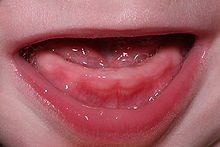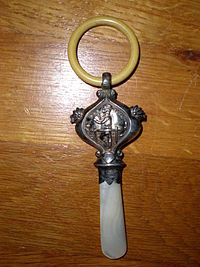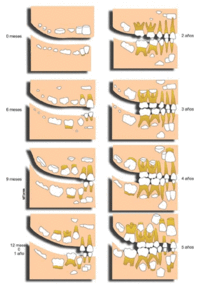- Teething
-
Teething is the process by which an infant's first teeth (the deciduous teeth, often called "baby teeth" or "milk teeth") sequentially appear by emerging through the gums. Teething may start as early as three months or as late, in some cases, as twelve months. The typical time frame for the first teeth to appear is somewhere between six and nine months. It can take up to several years for all 20 teeth to complete the tooth eruption; they typically arrive in pairs. Though the process of teething is sometimes referred to as "cutting teeth", when teeth emerge through the gums they do not cut through the flesh. Instead, special chemicals are released within the body that cause some cells in the gums to die and separate, allowing the teeth to come through.[1]
It is a widespread misconception that teething causes fever. Teething may cause a slightly elevated temperature, but not rising into the febrile range (above 100-101F, or above 38-38.2C). Higher temperatures during teething are due to some form of infection, such as a herpes virus, initial infection of which is extremely widespread among children of teething age.
Contents
History
Teething used to be considered (wrongly) a cause of death, as many children died in the first years of life, at the same time as teething occurs. "The tendency in the past to attribute serious disease to teething was so prevalent that in 1842 teething was the registered cause of death in 4.8% of all infants who died in London under the age of 1 year and 7.3% of those between the ages of 1 to 3 years according to the Registrar General's report."[2]
Ironically, whilst teething is a natural process which creates little more than discomfort, some methods for relieving teething pain have caused serious harm and even death. Old remedies for teething include "blistering, bleeding, placing leeches on the gums, and applying cautery to the back of the head".[3] In the sixteenth century the French surgeon Ambroise Paré introduced the lancing of gums using a lancet, in the belief that teeth were failing to emerge from the gums due to lack of a pathway, and that this failure was a cause of death. This belief and practice persisted for centuries, with some exceptions, until towards the end of the nineteenth century lancing became increasingly controversial and was then abandoned, although as late as 1938 an Anglo-American dental textbook advised in favour of lancing, and described the procedure.[4] In the first half of the twentieth century, teething powders in the English-speaking world often contained calomel, a form of mercury. It was removed from most powders in 1954 when it was shown to cause "pink disease" (acrodynia), a form of mercury poisoning.[5]
Teething toys have a long history. In England in the 17th–19th centuries, a coral meant a teething toy made of coral, ivory or bone, often mounted in silver as the handle of a rattle.[6] A museum curator has suggested that these substances were used as "sympathetic magic"[7] and that the animal bone could symbolize animal strength to help the child cope with pain.
Sequence of appearance
The infant teeth tend to emerge in pairs - first one lower incisor emerges then the other lower incisor emerges before the next set begin to emerge. The general pattern of emergence is:
- Lower central incisors (2) at approximately 6 months
- Upper central incisors (2) at approximately 8 months
- Upper lateral incisors (2) at approximately 10 months
- Lower lateral incisors (2) at approximately 10 months
- First molars (4) at approximately 14 months
- Canines (4) at approximately 18 months
- Second molars (4) at approximately 2-3 years
Milk teeth tend to emerge sooner in females than in males. The exact pattern and initial starting times of teething appear to be hereditary[citation needed]. When and how teeth appear in an infant has no bearing on the health of the child.
Teething symptoms
The level of pain that a baby can handle will be different for each child. Some may be a lot fussier than others while they are teething. The soreness and swelling of the gums before a tooth comes through is the cause for the pain and fussiness a baby experiences during this change. These symptoms usually begin about three to five days before the tooth shows, and they disappear as soon as the tooth breaks the skin. [8] Some babies are not even bothered by teething.
Common symptoms include drooling or dribbling, mood changes and feelings of irritability or crankiness and swollen gums. Crying, sleeplessness, restless sleep at night, and mild fever are also associated with teething. Teething can begin as early as 3 months and continue until a child's third birthday. [9] In rare cases, an area can be filled with fluid and appears over where a tooth is erupting and cause the gums to be even more sensitive. Pain is often associated more with large molars since they cannot penetrate through the gums as easily as the other teeth.
Some of the signs or symptoms that a baby has entered the teething stage will be actions that are noticeable. They may chew on their fingers or toys to help relieve pressure on their gums. Babies might refuse to eat or drink due to the pain. Symptoms will generally fade on their own, but a doctor should be notified if they worsen or are persistent. Teething may cause signs and symptoms in the mouth and gums, but it doesn't cause problems elsewhere in the body. [10]
Pulling on the ears is another sign of pain; the pain in the mouth throbs throughout the baby's head so they pull their ears believing that it will provide relief. Mild rash can develop around the mouth due to skin irritation that is caused because of excessive drooling or dribbling. [11]
Misdiagnosis as teething
Teething has not been shown to cause fever or diarrhea;[12] however the belief that teething causes fever is extremely common among parents.[13] Whilst there is some evidence that teething can cause an elevated temperature, it does not cause fever (temperature over 100-101F, or over 38-38.2C). One small 1992 study found a significant rise in temperature on the day of eruption of the first tooth.[14] Another study in 2000 found "mild temperature elevation" (but not fever over 102F).[15]
There is a risk that fever around the age of teething is dismissed as due to teething when it is actually due to illness, particularly infection by herpes viruses. "Coincidentally, primary tooth eruption begins at about the time that infants are losing maternal antibody protection against the herpes virus. Also, reports on teething difficulties have recorded symptoms which are remarkably consistent with primary oral herpetic infection such as fever, irritability, sleeplessness, and difficulty with eating."[16] "Younger infants with higher residual levels of antibodies would experience milder infections and these would be more likely to go unrecognized or be dismissed as teething difficulty."[17] Herpes virus infection may take the form of primary herpetic gingivostomatitis (HSV-1)[18][19] or of infection by human herpesvirus 6, which infects 90% of children by age 2.[20] "The symptoms of elevated temperature and facial rash could be explainable by infection with the Human Herpes Virus 6 (HHV-6) agent, which is ubiquitous among infants of teething age."[21] Other viruses may also cause fevers which may be misattributed to teething, but the oral involvement that may occur with herpes viruses makes misdiagnosis a particular risk for such infections.
Treatment
Before treating a baby for teething, it is important to know what is causing the baby to be upset. Rubbing a finger gently along the gums in search for swollen ridges or the feel of a tooth below the gums is one way to be certain. If unsure, it is recommended that the child be seen by a pediatrician before treatment is administered.
A teething ring is generally a soft plastic device that can be chewed on and allows the baby to break down some of the gum tissue which promotes the growth of the teeth out of the gum. Some teething rings can easily be broken or damaged, so other types of teething devices can be made from household items. Placing a wet washcloth in the freezer for a few minutes and then applying it gently to the gums can be effective, but care must be taken not to expose a baby's gums to coldness for too long.
Infants chew on objects to aid in the teething process. This can be dangerous if the baby is allowed to chew on objects which are small enough to be swallowed or which could break while being chewed and cause choking. Teething rings and other toys, called teethers, are often designed with textures that will appeal to an infant during teething. Drawing water into a pacifier and freezing it as another way to offer a teething child relief. The cold pressure on the gums gives relief without making the child’s fingers cold.
Some infants gain relief from chewing on cold objects. Some children respond well to chilled foods. Suggestions for chilled foods that might appeal to a baby include applesauce, yogurt, and pureed fruits.
Dentists recommend brushing infants' teeth as soon as they appear. It is not advisable to wait for the teething process to be complete. Dentists may recommend against the use of fluoride toothpaste during teething.
Not all parents are comfortable with the idea of using medications, and the U.S. Food and Drug Administration advises against it because of the risk of methemoglobinemia[2]. Instead to treat the pain, parents should use teething rings and gum massage.
Medication
In cases where the infant is in obvious pain, some doctors recommend the use of non-steroidal anti-inflammatories (NSAIDs) or child-safe pain-relief treatments containing benzocaine, lidocaine, or choline salicylate. Benzocaine must be used cautiously because it can cause methemoglobinemia;[22] choline salicylate is related to aspirin and "may cause Reye's syndrome in susceptible children, especially those with or recovering from viral infections, or when used in combination with other NSAIDs".[23] 5% lidocaine gel produces anaesthesia (numbing) within 2-5 minutes, lasting for 10-20 minutes.[24] However, one author concludes that "Overall, the risks and adverse effects from inappropriate or prolonged use of pharmacological agents outweigh their potential benefits."[25] She points out that "the psychological trauma involved in administering medications or applying topical preparations to infants must be considered",[26] and argues that "the placebo effect must not be overlooked. For example, applying a gel of 20% benzocaine in polyethelene glycol may give only a modest benefit over applying the placebo, which gives an efficacy of 60% compared with 90% for the active preparation."[27]
Medicines are often applied to the babies' gums to relieve swelling and pain. These gels are similar to the toothache gel that is used by adults for sore gums and toothaches, but is administered in much smaller doses. Teething gels work as a numbing agent to dull the nerves in the gums so that the pain is less noticeable. It is important to follow the directions on the package to ensure that the correct amount of medication is administered and that proper techniques are used to reduce the risk for infection. It is important not to let the medicine numb the throat as it may interfere with the normal gag reflex and may make it possible for food to enter the lungs. [28] Similar medicines are also available in powder form, as "teething powder".
Acetaminophen and ibuprofen are also recommended to treat the pain and swelling that babies experience, but should not be administered to babies under six months of age.[citation needed] It should only be used a few times a day so that it does not mask symptoms that are being experienced due to other medical conditions and not because of teething. Products that contain aspirin should never be given to a child unless directed by a pediatrician, due to the risk of Reye's syndrome.
Some traditional medicine used to treat teething pain has been found to be harmful due high lead content, with effects including toxic encephalopathy. "Surma" or "kohl" has traditionally been used in the Middle East and Indian subcontinent as a teething powder, as have the Middle Eastern "saoott"/"cebagin". "Santrinj" - a 98% lead oxide product otherwise used as a paint primer - is also used in the Middle East as a home remedy for teething.[29]
See also
References
- ^ Teething National Health Service of England
- ^ "Fever associated with teething". L Jaber, I J Cohen, A Mor. Archives of Disease in Childhood: short reports 1992. p234
- ^ "The lancet and the gum-lancet: 400 years of teething babies", Ann Dally, The Lancet, Volume 348, Issue 9043, 21-28 December 1996, Pages 1710-1711
- ^ "The lancet and the gum-lancet: 400 years of teething babies", Ann Dally, The Lancet, Volume 348, Issue 9043, 21-28 December 1996, Pages 1710-1711
- ^ Dally A (1997). "The rise and fall of pink disease". Soc Hist Med 10 (2): 291–304. doi:10.1093/shm/10.2.291. PMID 11619497.
- ^ OED; Examples from the Metropolitan
- ^ Victoria & Albert Museum of Childhood
- ^ Teething Overview WebMD. Retrieved on 2010-01-25
- ^ The Teething Process KidsHealth Portal. Retrieved on 2010-01-25
- ^ Infant and toddler health Mayo Clinic. Retrieved on 2010-01-25
- ^ Teething Symptoms eMedicine Health Portal. Retrieved on 2010-01-25
- ^ Tintinalli, Judith (2004). Emergency Medicine: A Comprehensive Study Guide, Sixth edition. McGraw-Hill Professional. p. 1483. ISBN 0071388753.
- ^ "Challenging parents’ myths regarding their children’s teething", AI Owais, F Zawaideh, O Bataineh, International Journal of Dental Hygiene, Volume 8, Issue 1, pages 28–34, February 2010. http://onlinelibrary.wiley.com/doi/10.1111/j.1601-5037.2009.00412.x/full
- ^ "Fever associated with teething". L Jaber, I J Cohen, A Mor. Archives of Disease in Childhood: short reports 1992. p234
- ^ Macknin ML, Piedmonte M, Jacobs J, Skibinski C. Symptoms associated with infant teething: a prospective study. Pediatrics. 2000;105:747–752. https://www.ncbi.nlm.nih.gov/pubmed/10742315
- ^ "Herpetic gingivostomatitis and teething difficulty in infants". David L. King, William Steinhauer, Franklin Garcfa-Godoy, Cassandra J. Elkins. PEDIATRIC DENTISTRY MARCH/APRIL, 1992 VOLUME 14, NUMBER 2. p83
- ^ "Herpetic gingivostomatitis and teething difficulty in infants". David L. King, William Steinhauer, Franklin Garcfa-Godoy, Cassandra J. Elkins. PEDIATRIC DENTISTRY MARCH/APRIL, 1992 VOLUME 14, NUMBER 2. p84
- ^ "Challenging parents’ myths regarding their children’s teething", AI Owais, F Zawaideh, O Bataineh, International Journal of Dental Hygiene, Volume 8, Issue 1, pages 28–34, February 2010. http://onlinelibrary.wiley.com/doi/10.1111/j.1601-5037.2009.00412.x/full
- ^ http://www.drugs.com/cg/primary-herpetic-gingivostomatitis-in-children.html
- ^ "A Population-Based Study of Primary Human Herpesvirus 6 Infection". Danielle M. Zerr, M.D., M.P.H., Amalia S. Meier, Ph.D., Stacy S. Selke, M.A., Lisa M. Frenkel, M.D., Meei-Li Huang, Ph.D., Anna Wald, M.D., M.P.H., Margaret P. Rhoads, B.A., Long Nguy, B.S., Rena Bornemann, M.D., Rhoda Ashley Morrow, Ph.D., and Lawrence Corey, M.D. N Engl J Med 2005; 352:768-776. http://www.nejm.org/doi/full/10.1056/NEJMoa042207
- ^ "Teething troubles?", G T McIntyre & G M McIntyre, British Dental Journal 192, 251 - 255 (2002) Published online: 9 March 2002 | doi:10.1038/sj.bdj.4801349, citing King DL Teething revisited. Pediatr Dent 1994; 16: 179–182.
- ^ [1]
- ^ "Teething, teething pain and teething remedies", Annetta K.L. Tsang, INTERNATIONAL DENTISTRY - AUSTRALASIAN EDITION VOL. 5, NO. 4. p18
- ^ "Teething, teething pain and teething remedies", Annetta K.L. Tsang, INTERNATIONAL DENTISTRY - AUSTRALASIAN EDITION VOL. 5, NO. 4. p18
- ^ "Teething, teething pain and teething remedies", Annetta K.L. Tsang, INTERNATIONAL DENTISTRY - AUSTRALASIAN EDITION VOL. 5, NO. 4. p23
- ^ "Teething, teething pain and teething remedies", Annetta K.L. Tsang, INTERNATIONAL DENTISTRY - AUSTRALASIAN EDITION VOL. 5, NO. 4. p23
- ^ "Teething, teething pain and teething remedies", Annetta K.L. Tsang, INTERNATIONAL DENTISTRY - AUSTRALASIAN EDITION VOL. 5, NO. 4. p23
- ^ Medications used to treat teething pain eMedicine MedicineNet. Retrieved on 2010-01-25
- ^ "Lead Encephalopathy Due to Traditional Medicines", Surya K. Karri, Robert B. Saper, and Stefanos N. Kales. Curr Drug Saf. 2008 January; 3(1): 54–59. http://www.ncbi.nlm.nih.gov/pmc/articles/PMC2538609/
External links
- NHS Choices Birth to Five Planner: Teething
- NHS Choices Health A-Z: Teething
- "Personal View: It's only teething... A report of the myths and modern approaches to teething", M P Ashley, British Dental Journal 191, 4 - 8 (2001) Published online: 14 July 2001 | doi:10.1038/sj.bdj.4801078. http://www.nature.com/bdj/journal/v191/n1/full/4801078a.html
Tooth development (TE 5.4) -blast General Dental papilla · Epithelial root sheath · Epithelial cell rests of Malassez
Enamel organ: Outer enamel epithelium · Inner enamel epithelium · Stellate reticulum · Stratum intermedium
Dentition · Teething · Tooth eruptionPulp occlusion Canalis amelodentineus · Fovea enamelea · Fovea dentineaCategories:- Infancy
- Teeth
Wikimedia Foundation. 2010.





